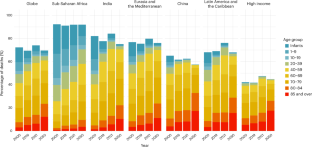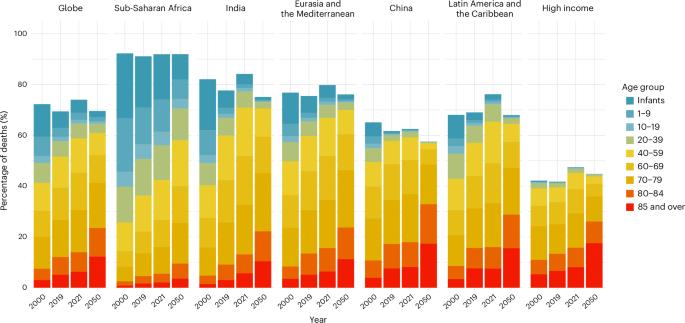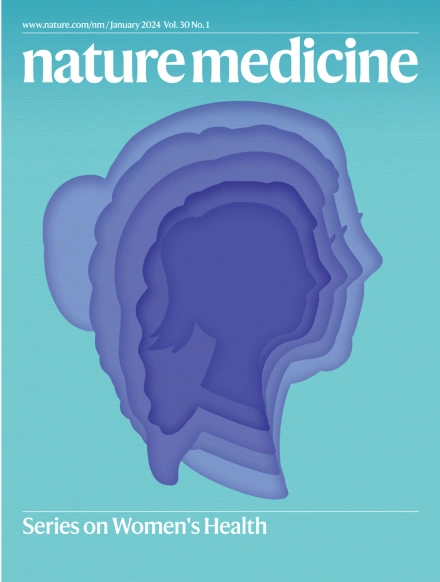降低可避免死亡率的经济价值
IF 50
1区 医学
Q1 BIOCHEMISTRY & MOLECULAR BIOLOGY
引用次数: 0
摘要
更长寿、更健康的生活可提高个人和家庭的福利。作为世界银行 "健康长寿倡议 "的一部分,我们量化了实现尽可能长寿的经济价值。我们估算了降低可避免死亡率的经济价值,可避免死亡率的定义是 2000 年至 2021 年期间,按世界地区、性别和年龄划分的观察到的(或预测的)死亡率与达到的(或预测的)最低死亡率之间的差异,并预测到 2050 年。2019 年,69% 的死亡率,即 4000 万例死亡是可以避免的。全球可避免死亡率的经济价值为年收入的 23%,这意味着全球人口愿意放弃约五分之一的现有收入,以换取一年以最低死亡率生活。这个数值从中国的 19% 到撒哈拉以南非洲的 34% 不等。在快速进展情景下,即从 2019 年到 2050 年,各国的死亡率会快速但合理地降低,我们预计到 2050 年,全球预计寿命与前沿寿命之间的差距将缩小一半,实现这一情景后的经济价值相当于年收入的 14%。我们的工作为提高健康水平带来的高经济价值提供了支持性证据。本文章由计算机程序翻译,如有差异,请以英文原文为准。


The economic value of reducing avoidable mortality
Living longer and healthier boosts individual and family welfare. As part of the World Bank’s Healthy Longevity Initiative, we quantified the economic value of achieving the highest possible life span. We estimated the economic value of reducing avoidable mortality, defined as the difference between observed (or projected) mortality and lowest achieved (or projected) mortality, by world regions, sex, and age, between 2000 and 2021, with projection to 2050. In 2019, 69% of mortality, or 40 million deaths, was avoidable. The economic value of avoidable mortality globally was 23% of annual income, meaning that, globally, populations would be willing to give up about one-fifth of their current income in exchange for a year living at the lowest achieved mortality rate. This value ranges from 19% in China to 34% in sub-Saharan Africa. Under the rapid-progress scenario, in which countries experience fast but plausible mortality reductions from 2019 to 2050, we would expect globally the gap between projected and frontier life expectancy to be halved by 2050, and the economic value after achieving this scenario is equivalent to 14% of annual income. Our work provides supportive evidence on the high economic value placed on improving health. Forming the recommendations of the World Bank’s Healthy Longevity Initiative, this analysis finds that the economic impact of avoidable mortality globally is equivalent to 23% of the annual income.
求助全文
通过发布文献求助,成功后即可免费获取论文全文。
去求助
来源期刊

Nature Medicine
医学-生化与分子生物学
CiteScore
100.90
自引率
0.70%
发文量
525
审稿时长
1 months
期刊介绍:
Nature Medicine is a monthly journal publishing original peer-reviewed research in all areas of medicine. The publication focuses on originality, timeliness, interdisciplinary interest, and the impact on improving human health. In addition to research articles, Nature Medicine also publishes commissioned content such as News, Reviews, and Perspectives. This content aims to provide context for the latest advances in translational and clinical research, reaching a wide audience of M.D. and Ph.D. readers. All editorial decisions for the journal are made by a team of full-time professional editors.
Nature Medicine consider all types of clinical research, including:
-Case-reports and small case series
-Clinical trials, whether phase 1, 2, 3 or 4
-Observational studies
-Meta-analyses
-Biomarker studies
-Public and global health studies
Nature Medicine is also committed to facilitating communication between translational and clinical researchers. As such, we consider “hybrid” studies with preclinical and translational findings reported alongside data from clinical studies.
 求助内容:
求助内容: 应助结果提醒方式:
应助结果提醒方式:


